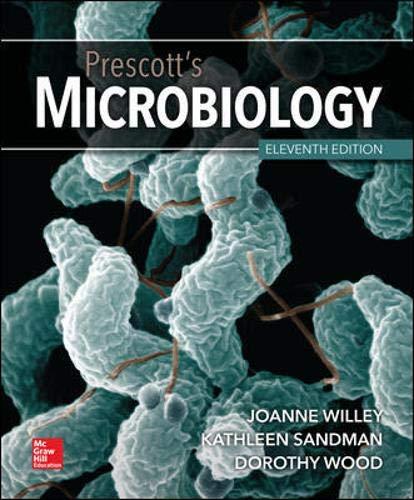
Prescott's Microbiology
11th Edition
ISBN: 9781260211887
Author: WILLEY, Sandman, Wood
Publisher: McGraw Hill
expand_more
expand_more
format_list_bulleted
Concept explainers
Question
Chapter 22.3, Problem 4CC
Summary Introduction
Gammaproteobacteria is the largest bacterial class with several groups of branches. The order Alteromonadales belong to the Gammaproteobacteria class and grouped in rRNA superfamily I. The Shewanella species belongs to the family of Alteromonadaceae.
Expert Solution & Answer
Want to see the full answer?
Check out a sample textbook solution
Students have asked these similar questions
Describe two different gene regulation mechanisms involving methylation
What is behavioral adapt
22. Which of the following mutant proteins is expected to have a dominant negative effect when over-
expressed in normal cells?
a. mutant PI3-kinase that lacks the SH2 domain but retains the kinase function
b. mutant Grb2 protein that cannot bind to RTK
c. mutant RTK that lacks the extracellular domain
d. mutant PDK that has the PH domain but lost the kinase function
e. all of the above
Chapter 22 Solutions
Prescott's Microbiology
Ch. 22.1 - What would Rhodospirillum rubrum use for carbon...Ch. 22.1 - How are bacterial cysts different from the...Ch. 22.1 - If Caulobacter bacteria were grown in a...Ch. 22.1 - What steps are also found in the TCA cycle? What...Ch. 22.1 - Why do nitrifying microbes possess intracellular...Ch. 22.1 - Prob. 6MICh. 22.1 - Prob. 1CCCh. 22.1 - Prob. 2CCCh. 22.1 - Prob. 3CCCh. 22.1 - Compare and contrast the life cycle of members of...
Ch. 22.1 - Prob. 5CCCh. 22.1 - Prob. 6CCCh. 22.1 - Prob. 7CCCh. 22.1 - Prob. 8CCCh. 22.2 - MICRO INQUIRY Suggest why N. europaea has PTS...Ch. 22.2 - MICRO INQUIRY Identify the reactions that...Ch. 22.2 - Prob. 1CCCh. 22.2 - Prob. 2CCCh. 22.2 - Prob. 3CCCh. 22.2 - How do colorless sulfur bacteria obtain energy by...Ch. 22.2 - Prob. 5CCCh. 22.3 - Prob. 1MICh. 22.3 - Prob. 2MICh. 22.3 - Prob. 3MICh. 22.3 - Prob. 1CCCh. 22.3 - Prob. 2CCCh. 22.3 - Prob. 3CCCh. 22.3 - Prob. 4CCCh. 22.3 - Prob. 5CCCh. 22.3 - Prob. 6CCCh. 22.3 - Prob. 7CCCh. 22.4 - Prob. 1MICh. 22.4 - What general features are common to most...Ch. 22.4 - Prob. 2CCCh. 22.4 - Prob. 3CCCh. 22.4 - Characterize Bdellovibrio spp. and outline the...Ch. 22.4 - Compare the growth of a myxobacterium in...Ch. 22.5 - What property unifies -proteobacteria?Ch. 22.5 - Prob. 2CCCh. 22.5 - Prob. 3CCCh. 22 - Prob. 1RCCh. 22 - Prob. 2RCCh. 22 - Prob. 3RCCh. 22 - Prob. 4RCCh. 22 - Prob. 5RCCh. 22 - Prob. 6RCCh. 22 - Prob. 7RCCh. 22 - Prob. 8RCCh. 22 - Prob. 9RCCh. 22 - Prob. 1ALCh. 22 - Prob. 2ALCh. 22 - Prob. 3ALCh. 22 - Prob. 4ALCh. 22 - Prob. 5ALCh. 22 - Prob. 6ALCh. 22 - Prob. 7ALCh. 22 - Prob. 8ALCh. 22 - Prob. 9AL
Knowledge Booster
Learn more about
Need a deep-dive on the concept behind this application? Look no further. Learn more about this topic, biology and related others by exploring similar questions and additional content below.Similar questions
- Explain how the hormones of the glands listed below travel around the body to target organs and tissues : Pituitary gland Hypothalamus Thyroid Parathyroid Adrenal Pineal Pancreas(islets of langerhans) Gonads (testes and ovaries) Placentaarrow_forwardWhat are the functions of the hormones produced in the glands listed below: Pituitary gland Hypothalamus Thyroid Parathyroid Adrenal Pineal Pancreas(islets of langerhans) Gonads (testes and ovaries) Placentaarrow_forwardDescribe the hormones produced in the glands listed below: Pituitary gland Hypothalamus Thyroid Parathyroid Adrenal Pineal Pancreas(islets of langerhans) Gonads (testes and ovaries) Placentaarrow_forward
- Please help me calculate drug dosage from the following information: Patient weight: 35 pounds, so 15.9 kilograms (got this by dividing 35 pounds by 2.2 kilograms) Drug dose: 0.05mg/kg Drug concentration: 2mg/mLarrow_forwardA 25-year-old woman presents to the emergency department with a 2-day history of fever, chills, severe headache, and confusion. She recently returned from a trip to sub-Saharan Africa, where she did not take malaria prophylaxis. On examination, she is febrile (39.8°C/103.6°F) and hypotensive. Laboratory studies reveal hemoglobin of 8.0 g/dL, platelet count of 50,000/μL, and evidence of hemoglobinuria. A peripheral blood smear shows ring forms and banana-shaped gametocytes. Which of the following Plasmodium species is most likely responsible for her severe symptoms? A. Plasmodium vivax B. Plasmodium ovale C. Plasmodium malariae D. Plasmodium falciparumarrow_forwardStandard Concentration (caffeine) mg/L Absorbance Reading 10 0.322 20 0.697 40 1.535 60 2.520 80 3.100arrow_forward
arrow_back_ios
SEE MORE QUESTIONS
arrow_forward_ios
Recommended textbooks for you
 Principles Of Radiographic Imaging: An Art And A ...Health & NutritionISBN:9781337711067Author:Richard R. Carlton, Arlene M. Adler, Vesna BalacPublisher:Cengage Learning
Principles Of Radiographic Imaging: An Art And A ...Health & NutritionISBN:9781337711067Author:Richard R. Carlton, Arlene M. Adler, Vesna BalacPublisher:Cengage Learning Biology: The Dynamic Science (MindTap Course List)BiologyISBN:9781305389892Author:Peter J. Russell, Paul E. Hertz, Beverly McMillanPublisher:Cengage Learning
Biology: The Dynamic Science (MindTap Course List)BiologyISBN:9781305389892Author:Peter J. Russell, Paul E. Hertz, Beverly McMillanPublisher:Cengage Learning Biology 2eBiologyISBN:9781947172517Author:Matthew Douglas, Jung Choi, Mary Ann ClarkPublisher:OpenStax
Biology 2eBiologyISBN:9781947172517Author:Matthew Douglas, Jung Choi, Mary Ann ClarkPublisher:OpenStax


Principles Of Radiographic Imaging: An Art And A ...
Health & Nutrition
ISBN:9781337711067
Author:Richard R. Carlton, Arlene M. Adler, Vesna Balac
Publisher:Cengage Learning



Biology: The Dynamic Science (MindTap Course List)
Biology
ISBN:9781305389892
Author:Peter J. Russell, Paul E. Hertz, Beverly McMillan
Publisher:Cengage Learning

Biology 2e
Biology
ISBN:9781947172517
Author:Matthew Douglas, Jung Choi, Mary Ann Clark
Publisher:OpenStax
Chapter 5 Microbial Metabolism; Author: Heather Davis;https://www.youtube.com/watch?v=wH_HrsfDWZw;License: Standard Youtube License